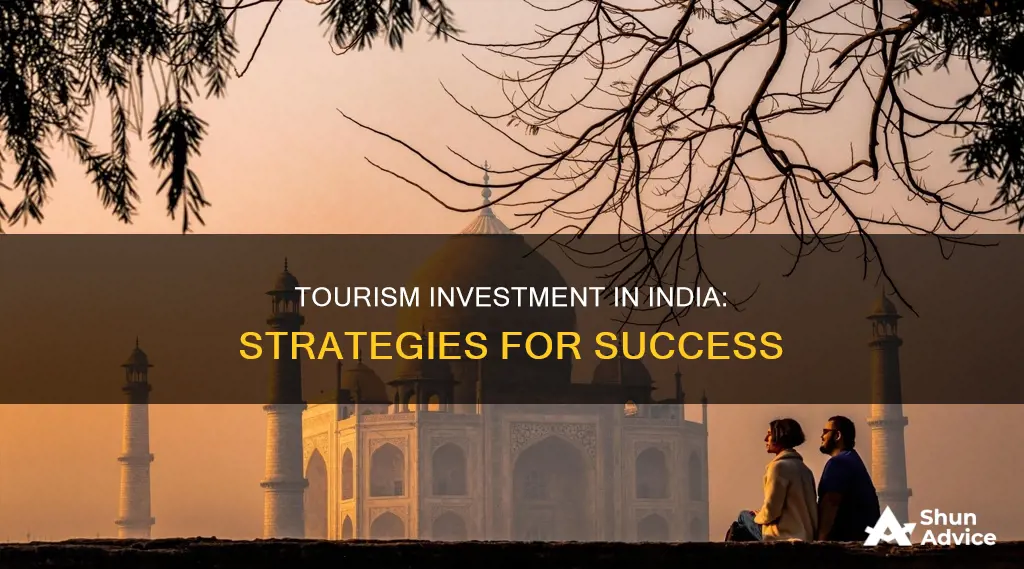
India's tourism industry is a significant economic driver, contributing to the country's GDP and foreign exchange earnings. The sector offers a range of investment opportunities, from hotels and resorts to niche tourism products such as medical, eco, and adventure tourism. With improved infrastructure, global connectivity, and a growing middle class, India's tourism market is projected to reach US$125 billion by FY 2026-27. The Indian government actively promotes tourism, and the recent Annual Investment Meeting in Abu Dhabi showcased best practices for attracting investments to the sector. India's diverse cultural and natural attractions, along with its favourable FDI policies, make it an attractive destination for investors in the tourism industry.
| Characteristics | Values |
|---|---|
| Current worth of the tourism market | Projected to be worth $125 billion by FY 2026-27 |
| Reasons for the projected growth | Improved infrastructure, more global connectivity, higher disposable incomes, and the development of niche tourism products |
| India's rank in contribution to travel and tourism GDP | 8th largest country |
| Tourism's contribution to foreign exchange | Third-largest foreign exchange earner in India until 2019 |
| India's rank in Travel & Tourism Competitiveness Index | 34th in 2019 (up from 65th in 2013) |
| India's diverse portfolio of niche tourism products | Cruises, adventure tourism, medical and wellness, MICE, eco-tourism, religious tourism |
| India's natural attractions | 3.3 million sq. km of land, 40 Unesco World Heritage sites, 10 bio-geographic zones, 105 national parks, 564 wildlife sanctuaries, 7,000+ km of coastline |
| India's projected international tourist arrivals by 2028 | 30.5 million |
| India's projected revenue from the tourism and hospitality industry by 2028 | Over $59 billion |
| India's rank in terms of Travel & Tourism total contribution to GDP in 2022 | 6th |
| India's rank in terms of Travel & Tourism Employment in 2021 | 2nd |
| India's rank on the World Economic Forum Travel & Tourism Development Index in 2024 | 39th |
| India's diverse natural landscapes | 70% of the Himalayas, 10 bio-geographic zones, 7,000+ km coastline, 3rd largest recipient of investment in travel and tourism industries |
What You'll Learn

Investing in hotels and resorts
India's tourism industry is a significant economic driver, with a projected market value of US$125 billion by 2026-27. The country's diverse landscape, rich cultural heritage, and improving infrastructure make it an attractive destination for international tourists.
The Indian government has recognised the importance of the tourism sector and is actively working to promote it through various initiatives. This includes the "Incredible India" brand, which helped the country achieve its highest number of international tourist arrivals in 2019, with 17.91 million visitors and a CAGR of 6.4% between 2014 and 2019.
Market Overview
India's hotel and tourism sector has attracted significant foreign investment, receiving a cumulative FDI inflow of US$15.89 billion between April 2000 and June 2021. The country's vast and diverse landscape offers a range of opportunities for hotel and resort development, from competitive to premium pricing.
Government Support and Initiatives
The Indian government has implemented several initiatives to boost the tourism sector, including:
- Easing compliance by introducing national models to streamline multiple licenses and permits.
- Providing capacity-building support to district and unit-level tourism staff.
- Collaborating with various ministries and institutions to foster convergence and effective collaboration among stakeholders.
- Embracing a destination-centric approach, recognising that tourists choose destinations based on holistic experiences.
- Promoting public-private partnerships beyond just capital investments, including partnerships with online travel agencies and aggregators for data-sharing initiatives.
Demand and Growth Potential
India's tourism sector is expected to grow significantly, with a projected contribution of US$512 billion to India's GDP and the creation of 53 million jobs by 2029. The country's ranking in the Travel & Tourism Competitiveness Index improved from 65th in 2013 to 34th in 2019, reflecting its growing attractiveness as a destination.
Niche Markets
In addition to traditional hotels and resorts, there are opportunities in niche markets such as:
- Timeshare resorts
- Convention centres
- Motels
- Serviced residences
- Heritage hotels
- Medical and wellness tourism
- Eco-tourism
- Adventure tourism
Key Players
When considering investment opportunities in the hotel and resort sector, it is essential to research established players in the market. Some leading international hotel chains include Marriott, Starwood Hotels, and Hilton. Additionally, large resort operators, such as Ryman Hospitality Group and Vail Resorts, specialise in massive resorts that cater to large travel groups and conventions.
Direct vs Portfolio Investment: Understanding the Key Differences
You may want to see also

Investing in cruises
India's cruise tourism is an exciting prospect for investors. The country's vast coastline and geographical diversity offer a range of exotic and unusual cruise experiences. From river cruises on the Ganges and Brahmaputra to coastal voyages along the Konkan Coast, there is a variety of options for travellers. The Indian cruise industry is expected to witness significant growth in the coming years, with passenger traffic projected to increase from 0.4 million to 4 million by 2032, and the economic potential rising from $110 million to $5.5 billion.
Market Potential and Growth
India's cruise industry has significant growth potential, driven by the country's diverse geographical offerings and increasing demand for tourism. The cruise passenger traffic is expected to increase tenfold by 2032, presenting a lucrative opportunity for investors.
Popular Cruise Destinations and Routes
- River Cruises: River cruises on the Ganges and Brahmaputra rivers offer a unique perspective on India's cultural and natural heritage. The Ganges river cruise, operated by Pandaw, includes a 14-night journey on the Upper Ganges, embarking from Kolkata or Varanasi. The Sunderbans Luxury Cruises also offer a memorable experience in the Sunderbans delta.
- Coastal Cruises: Coastal cruises are popular along India's western coast, particularly the Konkan Coast, with routes such as Mumbai-Goa, Mumbai-Diu, and Chennai-Trincomalee. The Cordelia Cruise liner is a popular choice for travellers seeking luxury and entertainment. Other routes include Mumbai-Lakshadweep, Mumbai-Cochin, and Chennai-Hambantota.
- International Cruises: International cruises departing from India are also gaining popularity, with destinations like Dubai, Male, Athens, Singapore, and Venice. The Jalesh cruise liner, India's first multinational cruise line, offers voyages to Goa, the Maldives, and Dubai.
Key Players in the Indian Cruise Industry
- Cordelia Cruise: Cordelia Cruise is a popular choice for luxury and entertainment, offering various routes along the Indian coast and international destinations.
- Angriya Cruise: Angriya Cruise operates between Mumbai and Goa, providing world-class entertainment, exquisite cuisine, and a range of amenities.
- Oberoi Motor Vessel Vrinda Cruise: This luxury cruise takes passengers through the backwaters of Kerala, offering cultural performances and a five-star experience.
- Jalesh Cruises: Jalesh Cruises is India's first multi-destination cruise line, offering entertainment, adventure activities, and exotic cuisines. Their routes include Mumbai to Goa, Mumbai to Diu, and Goa to Mumbai.
- Nefertiti Cruise: The Nefertiti Cruise offers an unmatched cruising experience, allowing passengers to rediscover the beauty of the Arabian Sea and the shores of Kerala, setting sail from Kochi to Kozhikode.
- Government-run Cruises: The Indian government operates cruises from the mainland to the Andaman Islands, with ships like MV Harshavardhana, MV Nicobar, MV Swaraj Dweep, and MV Nancowry.
Investment Opportunities and Government Support
The Indian government actively promotes cruise tourism and has designated 2023 as the 'Visit India' year. The government allows 100% Foreign Direct Investment (FDI) in the tourism sector, including tourism construction projects. The Ministry of Tourism is planning a Global Tourism Investors Summit to showcase investment opportunities in the industry.
Challenges and Risks
While the Indian cruise industry offers promising prospects, investors should also consider potential challenges and risks, such as infrastructure development, environmental concerns, and competition from other tourism segments.
In conclusion, investing in cruises in India presents a unique opportunity to tap into the country's diverse tourism offerings and growing demand for cruise experiences. With the government's support and the potential for significant growth in the industry, investors can explore a range of cruise routes and partnerships to capitalise on this exciting sector.
Betterment: Savings or Investment?
You may want to see also

Investing in medical tourism
India's medical tourism sector is a growing part of the country's economy, with its unique combination of modern and traditional medicine. The country's healthcare industry offers world-class doctors and hospitals that provide treatment at a fraction of the cost compared to other countries. This, along with its ancient systems of medicine, such as Ayurveda, Yoga, and Panchakarma, sets India apart as a medical tourism destination.
The Indian government has also taken several initiatives to promote medical tourism, such as the 'Heal in India' initiative, which aims to position the country as a global hub for medical and wellness tourism. The government has also proposed an outlay of US$28.7 billion for health and well-being, a significant increase from the previous year's budget. The Marketing Development Assistance Scheme (MDA) offers financial assistance to approved tourism service providers to promote an intricate nexus of facilities for tourists to stay. Publicity materials, such as brochures and CDs, intended to promote medical and health tourism, have also been circulated in target markets.
To maximise the potential of the medical tourism industry, there is a need for significant investments to make the healthcare industry and equipment more attractive to international patients. Proper infrastructure and standardisation are necessary, especially in guest houses where patients spend most of their time and are prone to infections. Additionally, there is an opportunity to sell Indian health insurance to foreigners, which could generate an additional $9 billion in patient inflow to India.
The medical tourism market in India is expected to reach US$13 billion by 2026, with the country aiming to triple its revenue within four years. India's medical tourism sector is already worth an estimated US$9 billion in 2022, with approximately 2 million patients visiting from 78 countries for medical, wellness, and IVF treatments. The most popular treatments sought by medical tourists in India include alternative medicine, bone marrow transplants, cardiac bypass, eye surgery, and joint replacement.
India's high-end healthcare system is comparable to the best in the world, with complex surgical procedures performed in world-class hospitals by acclaimed medical specialists at much lower costs. India also offers the advantage of a large English-speaking population, making it easier for foreigners to communicate and seek treatment without language barriers.
Private Investment: When Planning Exceeds Saving
You may want to see also

Investing in eco-tourism
India's tourism market is projected to be worth $125 billion by the 2026-27 financial year, and the country is the eighth-largest in terms of contribution to travel and tourism GDP. Ecotourism is a fast-growing segment of the market, with a sharp rise in popularity over the last ten years.
Ecotourism is a type of travel that focuses on the natural world, sustainability, and conservation. It allows travellers to experience nature while minimising their impact on the environment. Ecotourism activities include birdwatching, wildlife viewing, camping in natural areas, hiking, cultural visits to local villages, and educational tours about the environment.
India's vast range of wildlife reserves, national parks, beaches, mountains, and forests make it an ideal destination for ecotourism. Ecotourists can visit Kerala's backwaters, Karnataka's rainforests, the snow-capped peaks of Uttarakhand, and the remote mountain villages of Arunachal Pradesh, among many other destinations.
The Indian government has also implemented initiatives to encourage ecotourism, such as establishing protected areas and building eco-friendly infrastructure. There are currently about 80 national parks and 441 sanctuaries in India, which work to protect and conserve the country's wildlife.
- Develop eco-friendly infrastructure: Invest in building eco-friendly resorts, lodges, or tour companies that cater to ecotourists. Offer sustainable and environmentally conscious experiences for travellers.
- Conservation and protection: Support local organisations and NGOs working towards the enhancement and protection of India's natural resources. Collaborate with environmental education initiatives at the grassroots level.
- Community development: Invest in social enterprises or community-based organisations that provide economic opportunities for local communities through ecotourism. This can include training and skill development, as well as the development of local businesses such as handicrafts, organic farming, or eco-friendly products.
- Sustainable agriculture: Invest in sustainable agricultural practices and promote eco-friendly farming methods in rural areas. This can help reduce the negative impact of agriculture on the environment while also providing economic opportunities for local farmers.
- Environmental education: Develop educational programmes or initiatives that raise awareness about environmental issues and promote sustainable practices among travellers and local communities.
Chris Gardner's Life Savings Investment: A Fateful Decision
You may want to see also

Investing in religious tourism
India's religious tourism market is a significant component of its overall tourism industry, with about 60% of domestic tourism driven by religious fervour. The Indian government has recognised the importance of religion to tourism and is investing in marketing and infrastructure development to attract more visitors. Here are some ways to invest in religious tourism in India:
Infrastructure Development
The Indian government has been developing and improving tourism and pilgrimage sites through various schemes such as the Swadesh Darshan Scheme and the Pilgrimage Rejuvenation and Spiritual Augmentation Drive (PRASAD). These schemes aim to transform pilgrimages into spiritual centres and promote tourism in specific regions by developing thematic circuits. Under these schemes, the government has identified 13 thematic circuits, including the Buddhist Circuit, Himalayan Circuit, and Spiritual Circuit. The government has allotted significant funds for the integrated development of these tourist circuits, and private investment in this area can help enhance the visitor experience and improve site management.
Hospitality and Transport Infrastructure
With millions of pilgrims visiting Indian pilgrimage sites each year, investments in hospitality and transport infrastructure are crucial. This includes developing and improving accommodation facilities, transportation networks, and city infrastructure to manage the high footfall of tourists. Private investment in these areas can help create a more comfortable and accessible experience for religious tourists.
Technology Employment
Technology plays an increasingly important role in religious tourism, with virtual pilgrimages, live streaming of religious ceremonies, and online viewing of deities gaining popularity. Investing in technology solutions, such as virtual reality experiences or interactive apps, can enhance the visitor experience and attract more tourists. Additionally, technology can improve information access and streamline processes, such as through the introduction of an e-pass system for certain sites.
Marketing Campaigns
The Ministry of Tourism in India runs marketing campaigns aimed at showcasing the country's rich spiritual and cultural heritage to faith-based tourists. Investing in innovative marketing strategies, such as utilising social media platforms and collaborating with travel bloggers and influencers, can help reach a wider audience and attract more religious tourists to India.
Yoga Retreats and Ayurvedic Spas
Yoga retreats and Ayurvedic spas are gaining popularity among domestic and foreign tourists, adding a spiritual and healthcare twist to religious tourism in India. Investing in developing and promoting these experiences, particularly in popular religious destinations, can tap into this growing market segment.
By investing in these areas, businesses can capitalise on the growth of religious tourism in India and contribute to the overall development of the country's tourism industry.
Understanding the Investment Management Division of the DOT
You may want to see also
Frequently asked questions
India's tourism market is projected to be worth $125 billion by the fiscal year 2026-27. The country's tourism sector is expected to grow at an annual rate of 10.35% between 2019 and 2028 and is projected to contribute $512 billion to India's GDP by 2029.
The Indian government has been working to boost tourism arrivals through initiatives such as the "Incredible India" brand, which resulted in a record 17.91 million international tourists in 2019. The government has also established best practices to attract investment in the tourism sector, including embracing a destination-centric approach, promoting convergence and ease of doing business, adopting an investor-centric approach, and diversifying public-private partnerships.
There are several sub-sectors within India's tourism sector that offer investment opportunities, including tourism infrastructure (such as hotels and accommodation), eco-tourism, and niche tourism products such as medical and wellness tourism, adventure tourism, and religious tourism.
Investing in India's tourism sector can provide access to a large and growing market, with increasing disposable incomes and a rising middle class. India offers geographical diversity, attractive beaches, UNESCO World Heritage sites, national parks, and wildlife sanctuaries. Additionally, the Indian government has liberalized access to the tourism market, allowing 100% Foreign Direct Investment (FDI) in the tourism sector and tourism construction projects.
The India Investment Grid (IIG) is an online portal that showcases investment opportunities across India, including in the tourism sector. The Ministry of Tourism is also planning to organize a Global Tourism Investors Summit to showcase opportunities for investment and trade in the tourism sector.







